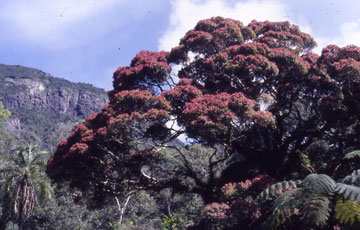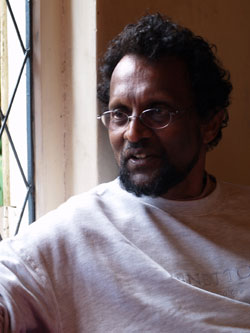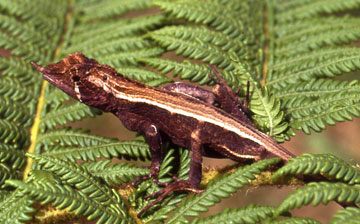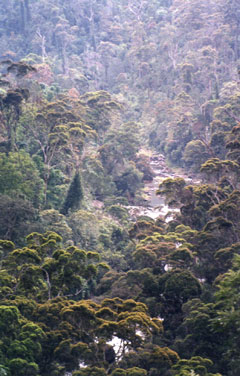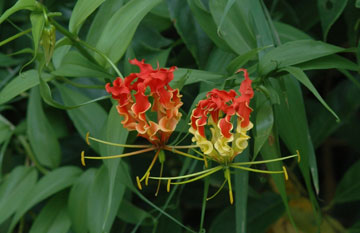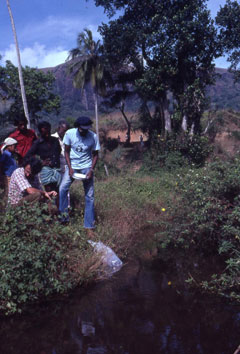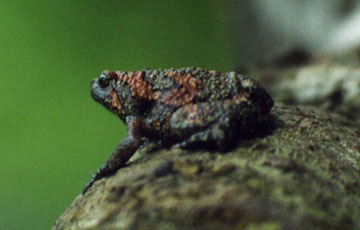Sri Lanka’s rainforests fast-disappearing but hope remains
An interview with Dr. Ranil Senanayake, chairman of Rainforest Rescue International:
Sri Lanka’s rainforests fast-disappearing but hope remains
Rhett A. Butler, mongabay.com
November 6, 2006
Reintroduction of concepts of sustainable livelihood key to saving Sri Lanka’s magnificent biodiversity says rainforest expert
Sri Lanka, an island off the southern-most point of India, is known as a global biodiversity hotspot for its high number of species in a relatively limited area. The island’s frog diversity illustrates this point: despite covering only 0.013 percent of the world’s land surface, Sri Lanka is home to more than 2 percent of the world’s known frog and toad species. The island is also home to 3,210 flowering plant species, of which 916 species are endemic. Overall, about 27 percent of the country’s plants and 22 percent of its amphibians, birds, mammals, and reptiles are endemic.
|
|
While Sri Lanka may be known for its biodiversity, this biological wealth is highly threatened—a 2005 survey found that 17 of Sri Lanka’s frogs have disappeared in the past decade and another 11 species face imminent extinction unless their habitat is protected. Habitat loss is the leading threat to Sri Lanka’s native ecosystems. Conservation International estimates that only around 1.5 percent of the island’s original forest remains (U.N. figures are more optimistic). Much of this forest was lost under British colonial rule, when large tracts of forest were cleared for rubber, coffee, and tea plantations, but Sri Lanka’s forests have also suffered dearly under years of civil war which has led to large-scale forest clearing. During the 1980s and early 1990s, government soldiers cleared the island’s lowland forests and mangrove forests because they served as refuges for rebel forces. At the same time, fighting destroyed homes and displaced small-scale farmers who then sought new lands in forested areas. Government figures show that the army and Tamil rebels felled more than 2.5 million palmyrah trees alone for construction purposes.
Over the past 15 years (1990-2005), Sri Lanka has had one of the highest deforestation rates of primary forests in the world. In that period the country lost more than 35 percent of its old-growth forest cover, while total forest cover was diminished by almost 18 percent. Worse, since the close of the 1990s, deforestation rates have increased by more than 25 percent.
|
|
Working to slow further loss of Sri Lanka’s biologically-rich rainforests is Rainforest Rescue International (RRI) ( www.earthrestoration.org), a conservation organization based in the southern Sri Lankan city of Galle. Focused on biodiversity conservation at the community-level, RRI aims to “reintroduce the concept of sustainable livelihood” to the people living in and around the island’s rainforests by establishing “commercially viable projects that explore the social and cultural relationships between people and ecology in the past, present and future.”
In November 2006, Dr Ranil Senanayake, Chairman of RRI, graciously answered some questions on Sri Lanka’s biodiversity and conservation efforts in the country. A former professor at the University of Melbourne in Australia and Monash University (Melbourne), Dr Senanayake has consulted for the United Nations Environment Programme (UNEP), United Nations Development Programme (UNDP) and the World Bank on matters of biodiversity and forest rehabilitation.
Mongabay: Tell us a little about Sri Lanka’s rainforests and biodiversity.
Senanayake: Sri Lanka’s Rainforests can be traced back to the mountains of Gondwanaland some 20 million years ago. They moved across the island in response to climate changes through this time but because of the shape of the mountains always had refugia in the South Western quarter. The biodiversity developed as a response to the mountains acting as ‘islands’ during times of drought and desiccation. Thus, the rainforests contain elements of a relict fauna, once shared with Africa. The bizarre horned lizards of the Genus Ceratophora are an example.
|
|
These forests remained generally inviolate since their formation, the Sinhalese civilizations who maintained historical records going back over 2200 years do not indicate the use of the mountains and rainforests for settlement or agriculture. It was only towards the 15th and 16th centuries that the montane zone became populated, but even then, the only anthropomorphic landscapes of consequence were in the flood plains of the river valleys, which were turned into rice fields.
The Rainforests began to be impacted and the “Continuous Forest’ landscape gave way to the “Colonial’ landscape’ around 1700-1800. Forests were felled for timber export and plantation industry was in its infancy with small monocultures of Cinnamon. The large scale felling of forests began after 1820 when all land without title was deemed ‘crown land’ and sold to commercial interests in the West. The ‘coffee boom’ of 1835 was a rush for land that was only equalled by the rush for land during the gold discoveries in the U.S.
The early colonial landscapes saw the creation of new ecosystems or ‘agro ecosystems’ that usually had exotic organisms as the dominant species. They contained large areas of monoculture, first coffee, then tea, rubber and coconut; these ecosystems replaced the more diverse indigenous forms. Coffee and tea replaced montane forests, rubber replaced lowland rainforest and coconut replaced lowland rainforest and evergreen forest. A further problem with these crops was the fact that large quantities of firewood were required in processing for export. The source of firewood was from the forest ecosystems of the landscape. Thus this period saw a reduction of indigenous landscapes not only as a consequence of forest clearing, but also as a consequence of timber and firewood extraction. Much of the original agricultural endeavour at this time did not pay any heed to good management practices. Thus large areas began to loose topsoil, became impoverished and were abandoned to become fire maintained grasslands. Indigenous landscapes were transformed, the new landscape containing far less natural forest.
The late colonial period saw landscapes that were being managed to sustain some element of ecological stability. The lessons of land degradation were learnt early and sound land management practices were instituted. Shade trees, windbreaks, contour planting; terracing and draining began to emerge as management characters. Even at this time the loss of indigenous species and ecosystems was occurring,
The loss of rainforest biodiversity in the last two hundred years is incalculable. Simply in terms of soils alone the loss is not confined to nutrients and organic matter, the loss of species specialized for life soil ecosystems is suggested by the existence of a large number of genera and species of earth snakes, such as Rhinophis, Aspidura, Thyphops and Aspidura suggest the diversity of the ecosystems that they once evolved in.
|
|
Currently most of the existing patches of rainforest come under the purview of the Forest Department, which unlike the Wild Life Department have neither history nor mandate on Biodiversity conservation. Thus much of the Forest patches are designated ‘multiple use’ indicating that timber extraction is a valid activity in these forests. All Rainforest patches need to be identified and strict conservation status conferred upon them if the massive loss of biodiversity is to be slowed.
The fragmentation of the rainforests into small patches means that current data collecting procedures have also to be addressed. For instance, in Sri Lanka, extinctions may have occurred as a consequence of the destructive sampling methods utilized in taxonomically listing species. Thus in a world of rapidly shrinking habitats the value of destructive sampling has to be questioned. It is clear that taxonomy and conservation have come to a divergence point today. Utmost care has to be exercised in collecting and preserving specimens. Confusing taxonomy with conservation may have serious national repercussions. Thus the assessment of species within restricted or fragmented ecosystems must develop other approaches than through destructive sampling.
Mongabay: Sri Lanka is known for its high levels of biodiversity but according to U.N. figures, primary forest today covers only 2.6 percent of the country and deforestation rates have climbed by 25 percent since the 1990s. What’s driving this increase in deforestation? Going forward, what are the greatest threats to the country’s ecosystems and biodiversity?
Senanayake: The greatest threats to Sri Lanka’s biodiversity are through greed and ignorance. Greed, as fuelled by the rush for instant capitalization of natural assets. Ignorance of the complex nature of the island’s diverse but integrally connected ecosystems.
What has been the ecological impact of the ongoing conflict between government and the Tamil forces?
There has been destruction of much forest and mangrove areas to provide less cover for the antagonistic parties. However, many wetlands and other critical ecosystems in the ‘war zone’ have been spared the pillaging that follows the ‘economic development’ agents, who treat all land as a commodity to be exploited for instant economic gain.
Mongabay: Have you seen any consequences of deforestation and biodiversity loss?
Senanayake: Absolutely. But let me quote Fedrick Lewis in his book Sixty-Four Years in Ceylon who makes this observation on the destruction of the mountain forests in 1830:
|
|
“I know of no more awe-inspiring sight, than that of a thousand acres on fire. Sheets of flame appear to leap into the air, and yell with a sort of devilish delight at their victory over the magnificent trees they are reducing into charred masses of cinder and charcoal. It is more than impressive; it is fearful, yet grand! After the fire has completed its work, the land is covered with black logs, lumps of charred timber, masses, and often-great fragments of stones, broken by the heat that has swept over them. A deep black covers the landscape; impressive, but depressing.
It was in a burned wilderness like this, that I found my new home. It lay at the extreme end of one of the many blocks of land that had been simultaneously burned off. My path, for road it could not be then called led over hundreds of fallen and charred logs, and followed the valley of the Agra stream
When morning broke upon the day following the events recorded at the conclusion of the last chapter, I found myself gazing upon a scene not altogether unfamiliar to me. All around me lay hundreds of charred black logs, stumps in fantastic shapes and outlines: fallen branches, broken and distorted by fire: cinder heaps, and little rivulets of sodden ash: all indicative of the fierce, merciless fire that but a few weeks ago, had raged over a spot that so lately had been a beautiful forest land.
It was now a blackened wilderness, to be changed into fields of coffee, by the labour and patience of man. A strange picture; fascinating in one respect: fearful in another and yet so full of a strange mixture of possibilities was this wild heap of ruins, this uncouth mass of slaughtered giants of an inarticulate, yet eloquent world, to be transformed by, industry in the pursuit of fleeting wealth.”
Today, the loss of these forests and their invaluable topsoil has created problems in water retention, poor water quality, dependence on artificial fertilizers for crop production, increase in communicable diseases and social strife.
I have personally witnessed many World Bank, Asian Development Bank, FAO and other international donor aid being used to change and destroy critical ecosystems in the name of ‘Agricultural or Forestry Development’. The influx of Weedicides and biocides (Sri Lanka enjoys the dubious title of the country with the highest rates of pesticide related deaths in the world) has created havoc with out native biodiversity.
Mongabay: What’s being done to protect Sri Lanka’s forests? Are international conservation organizations involved in the effort? Are grassroots movements active?
Senanayake: The public interest in Rainforests is just being promoted by Rainforest Rescue International (RRI) ( www.earthrestoration.org). While there has been substantial international interest the public locally, still view these forests as ‘wet and full of leeches’. This perspective needs to be changed through a large public awareness campaign. Another urgent need is to obtain biodiversity conservation status for the remnant patches. RRI are involved in creating a rainforest corridor that will link the last remaining patches of rainforest through land purchase, donation and easement establishment. The promotion of Developing Forest Garden Farms through the use of Analog Forestry in the buffer areas is also being promoted at the moment. The Analog Forestry (AF) approach seeks to integrate threatened rainforest species with agricultural production units and can reverse otherwise ‘irreversible’ trends towards extinction for many rainforest species.
There are not many international organizations involved in the conservation of rainforests at present. RRI is engaged in the task of building up Community Based Organizations (CBOs) to assume responsibility for the conservation of rainforests within and around their communities. This approach to integrate threatened rainforest species with agricultural production units is called. The involvement of International Conservation Organizations to help check this massive loss of biodiversity will be welcome.
Mongabay: In Aceh and other parts of Indonesia affected by the 2004 tsunami, unsustainable logging for housing reconstruction has be rampant. Has the tsunami recovery effort impacted conservation efforts in Sri Lanka?
Senanayake: Not really. Although there have been some instances of a few Foreign NGOs who turned a blind eye to the origin of their construction timber. We have too little forest resources for a massive response like that what was required after the tsunami. To respond we merely increased our import of unsustainably logged timber from Malaysia and Indonesia. So you could say that the Tsunami response in Sri Lanka was to increase the pressure on other Asian rainforests.
Mongabay: The cherry barb a popular aquarium fish from Sri Lanka but habitat loss has rendered it virtually extinct in the wild. I understand you have a fish conservation project. Can you tell us more about this effort?
|
|
Senanayake: The Cherry Barb (Puntius titteya) is a very beautiful rainforest fish. It is also very intolerant of pollution and habitat disturbance and studies have demonstrated a strong correlation between a decline of this species and increasing human impact. This makes it a very useful indicator species of habitat degradation.
During my studies of the Freshwater Fishes of Sri Lanka the very precarious nature of this species in its natural range became apparent. The South Western or ‘Rainforest Quarter’ of the Island, is being subject to enormous population pressure and water quality degradation through, urbanization, toxic drain off from agriculture and irresponsible mining methods for Gems. My studies indicated a translocation area with high potential identified in another river drainage, whatever endemic species existed in this drainage had been rendered extinct by the massive clearing by the British plantation industry a hundred years ago. Current studies clearly identified ’empty’ niches. Thus about 100 specimens were translocated to their ‘new’ watershed in 1981; today stable populations numbering many thousands of individuals have established in the new region, thereby reducing the threat of extinction in the wild.
I believe that such activity will have to be more frequent in the future if we are to maintain species in the human influenced landscapes and as a response strategy to global warming and attendant ecosystem loss.
Mongabay: How else are you working to conserve nature in Sri Lanka?
Senanayake: RRI is working to establish a rainforest corridor that will connect the largest rainforest fragments in the South . We have also initiated a program to develop Galle (the largest city in the South) as a ‘Rainforest City’. This program will use the municipality to promote all city landscaping to use native rainforest species and will develop ‘An Ecotourist map ‘ of Galle, where nature trails, forest fragments within the city, old growth trees, bicycling paths and walking trails through the city will be identified. RRI is also developing an ‘Adopt —a —Stream’ program for rainforest schools to sensitize the children to their environment and an Amphibian Survey of the lowland rainforests. At present RRI operated seven community nurseries where rainforest plants are propagated and given to the community for enrichment planting within the village.
Mongabay: How can Sri Lanka’s forests be saved? What can locals do to protect biodiversity without sacrificing their quality of life?
Senanayake: Like all countries on the planet, the standing forests of Sri Lanka represent only a tiny fraction of what once existed. The area lost is constantly degrading. Restoration of these lands to become friendlier to rainforest biodiversity is the challenge before us. The management of these anthropogenic areas for conserving native biodiversity needs greater and urgent attention. The current approach to conservation with its focus on pristine ecosystems may have obscured the most urgent threat to biodiversity, the degradation of biodiversity on anthropogenic ecosystems.
|
|
The issue of restoration must become a mainstream concern. Economic and policy decisions create a climate conducive to placing a value on restoration, such critical activities are developed and the current trend can be addressed. The greatest resources to respond to these goals of restoration are the rural poor. It is only the day-to-day attention to new plantings in the field and an increasing knowledge on the theory and practice of restoration that will produce the healed environments of tomorrow.
Consideration of the rural populace as key players in land management and rewarding them for the maintenance ecosystems benign to endemic biodiversity is important because it is the rural person who will ultimately be responsible for the acts that destroy or develop biodiversity. In this way local communities can protect biodiversity without compromising their lifestyles.
Mongabay: Is there anything a Sri Lankan living abroad can do to help?
Senanayake: Yes there are many things they could do. The first would be to become informed of the nature of the threats to the rainforests of Sri Lanka. The second would be to lobby for more stringent protection through their contacts back home. The third would be to support the ongoing projects by donating, money, time or equipment. Finally, plan a trip to visit the rainforests whenever they visit home.
Mongabay: What about the general public?
Senanayake: Support rainforest conservation through choosing products that have been certified to protect rainforest biodiversity. Influence corporations connected to rainforest destruction by not purchasing their products or shares to empower them. Support organizations working for the protection of rainforests. Interact with local organizations working on rainforest conservation on the Internet. Become aware of corporate greenwash. Demand that the organizations requesting donations set up web pages that allow you to visit the projects that you support. If possible, visit rainforests.
About Dr. Ranil Senanayake
Born in Colombo, Sri Lanka, Dr. Senanayake was educated at St. Thomas’ College in Sri Lanka and the University of California, Davis where he earned a Doctorate in Systems Ecology.
Dr. Senanayake has been a Senior Research Fellow at the University of Melbourne where he worked on the development of Land Care strategy and a Senior Lecturer at the Monash University at Melbourne where he taught Applied Forest Ecology. He is the developer of the concept of Analog Forestry that has attracted a global network of practitioners.
Dr. Senanayake is currently chairman of Rainforest Rescue International in Sri Lanka. He also conducts research into sustainable land use systems and biodiversity development.
Dr. Senanayake has been a consultant for UNEP, UNDP and the World Bank on matters of biodiversity and forest rehabilitation. Presently Dr. Senanayake is the Scientific Director for Counterpart International for their Forest Garden Program In Sri Lanka, Guatemala, Viet Nam and the Philippines. He has an extensive knowledge of marketing of organic products having developed and served as the chairman of Sri Lanka’s largest organic product export company Lanka Organics Ltd. Dr. Senanayake has worked as NASAA’s first International Crops Inspector and was responsible for the certification of much of the highland smallholder coffee in Papua New Guinea.
Dr. Senanayake has also served on the Biodiversity sub-committee of the International Federation of Organic Agriculture Movements (IFOAM) and developed the certification system for Green Gold’ for responsible mining operations in the Choco, Colombia. He is presently developing the standards for the Certification of Forest Garden Products (FGP’a) a system that evaluates the affectivity of applying Analog Forestry restoration projects. He also serves on the review committee of Fair Flowers and Plants (FFP) a European initiative to certify the cut flowers and plants entering the trade in Europe.
